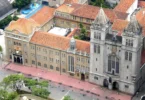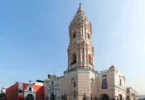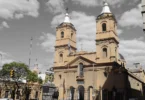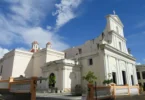Introduction
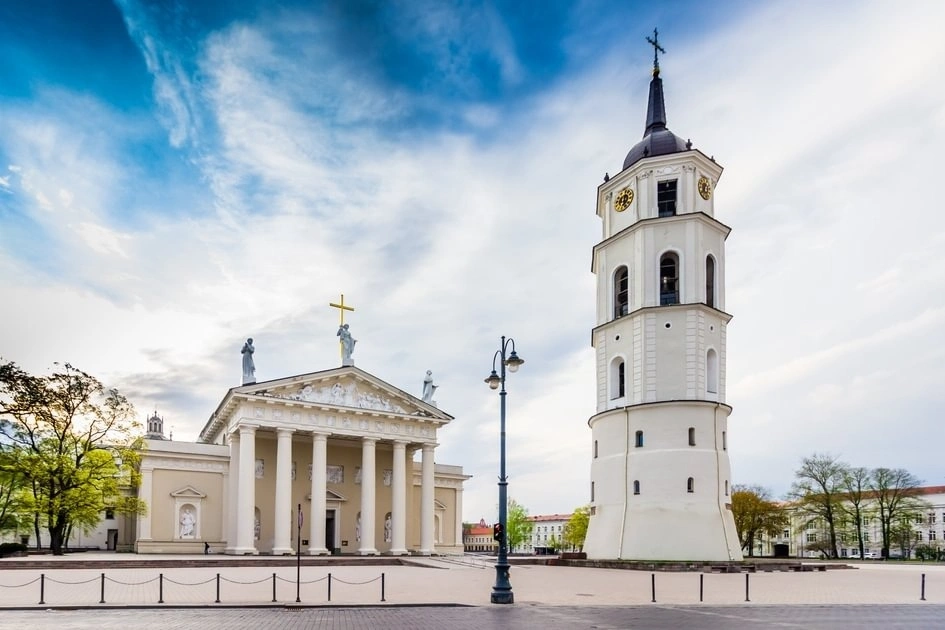
The official name of the Vilnius Cathedral, the Cathedral Basilica of St. Stanislaus and St. The most important Catholic church in Lithuania is Ladislaus. It is on Cathedral Square, right in the middle of Vilnius Old Town, and used to be part of the Lower Castle’s territory. This cathedral is more than just a landmark; it is also deeply connected to the nation’s history, faith, and identity. The structure is one of Lithuania’s finest examples of the classicist architectural style. It has been a place of national significance as well as a religious center over the centuries. Gediminas’ Cap served as a symbolic crown for Lithuanian monarchs in the past. Today, the Seimas Palace is where newly elected Lithuanian presidents take their oaths and attend mass following their inauguration. The cathedral is home to St. Ten additional side chapels, including Casimir’s Chapel. One of the most recognizable elements of the city skyline is the 57-meter-tall bell tower that can be found just outside. For many people, the cathedral is not only a place of worship but also a powerful symbol of Lithuania’s spirit, endurance, and faith.
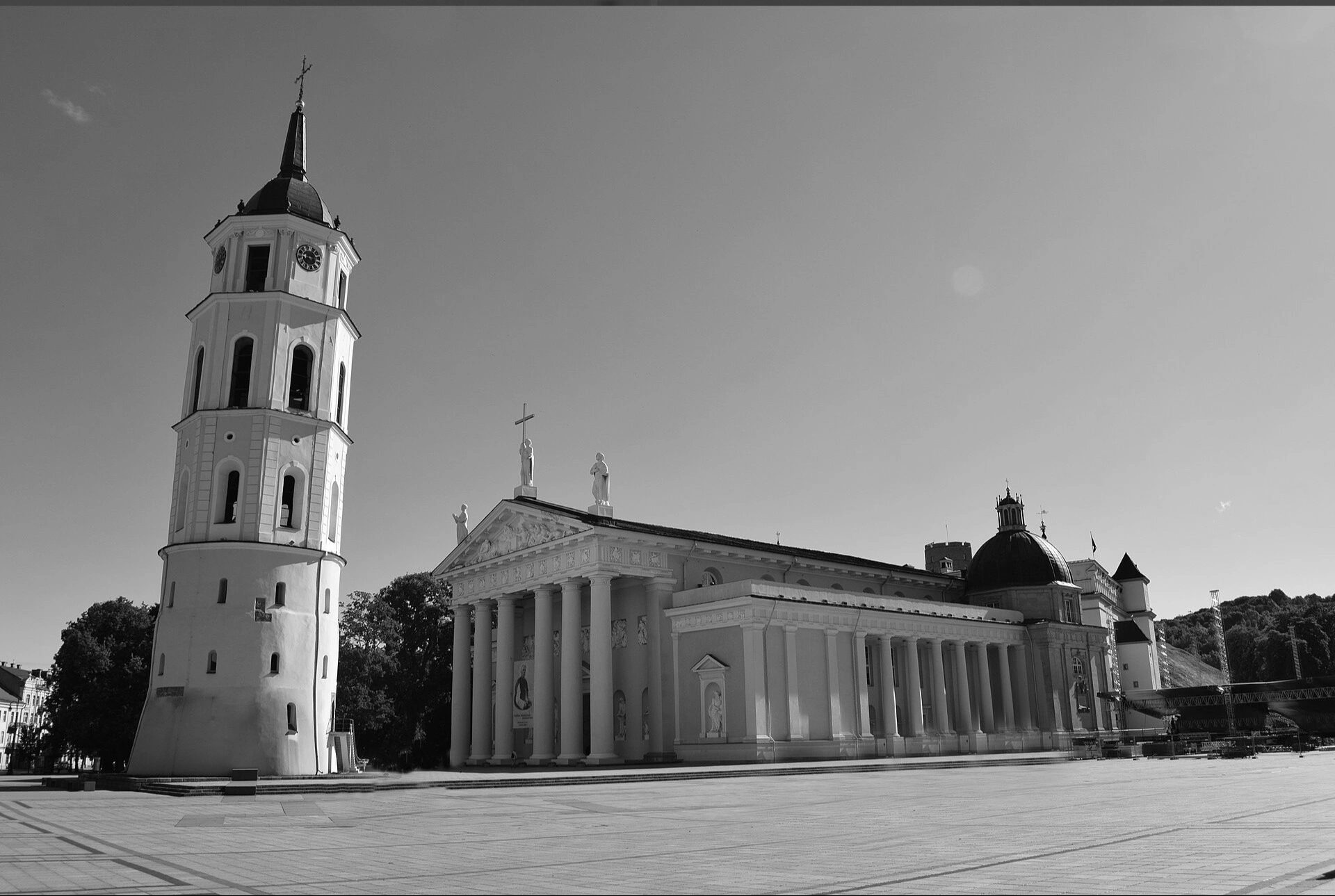
According to some old legends, there was a sacred fire burning here before the cathedral was built. Some people even think that this was once the location of a pagan altar or temple dedicated to the thunder god Perknas. In the middle of the 13th century, the very first cathedral was built. In 1251, when King Mindaugas became a Christian, the Pope told him to buy land for the cathedral. The first structure was square in shape and had a straightforward gable roof, combining Romanesque and Gothic styles. It had a Gothic entrance, three windows with pointed arches on the front, and a window in the pediment that looked like a Greek cross. In the present day, portions of its foundation can still be seen in the basement. It is possible that the cathedral was repurposed as a pagan temple following Mindaugas’s death in 1263. After Lithuania officially converted to Christianity in 1387, a new church with five chapels and a presbytery was built on the site. It was consecrated in 1388 and dedicated to the Holy Trinity, Holy Mary, St. Stanislaus and St. Wladyslaw. A school, probably the first in Lithuania, was established nearby. Sadly, this cathedral was destroyed by fire in 1419. Soon after, Grand Duke Vytautas built a much larger, three-nave Gothic cathedral. It stood taller than the current one and was grand. It still has pillars and portions of its walls. It’s said this cathedral was inspired by the Gothic cathedral in Frombork. A number of chapels were added over time, some of which had crypts beneath them. The roofs were decorated with tiles, lead, or even gilded. Rhetoric, music, dialectic, and Latin were taught at a school with three classes near the cathedral by the beginning of the 15th century. An Italian architect renovated the cathedral in 1522 and added a bell tower to an existing defensive tower. The cathedral was then rebuilt by Italian architects using Renaissance elements after another fire in 1530 destroyed it. Grand Duke Vytautas’ marble tombstone, carved in Krakow, was even ordered by Queen Bona. The cathedral experienced numerous fires and repairs between the 16th and 17th centuries. It became the location of significant coronations, including Sigismund Augustus’s 1529 coronation. A number of chapels, including the well-known St. Casimir Chapel, built in the Baroque style in the early 1600s by royal architects. The saint’s ashes are kept in this chapel. Lithuania’s patron saint is Casimir. During wars, the cathedral was damaged, especially when Russian troops looted it in 1655, possibly destroying Vytautas’ grave. After a tower collapsed in 1769, killing six people, the cathedral fell into disuse for a while.
In the latter part of the 1700s, the architect Laurynas Gucevius began a significant reconstruction. He gave the cathedral its present classical look with a portico of Doric columns and unified the chapels. The facade was embellished with carvings of the evangelists by Italian sculptor Tomaz Rigis. In the 19th century, the cathedral was repaired again, new organs were installed, and some chapels were restored or redecorated. In 1922, it was granted the title of basilica, and in 1925, it became an archcathedral. The 20th century was difficult. Floods in 1931 caused damage to the foundations, but repairs were made quickly.The Soviet era was particularly difficult: the cathedral was closed, sculptures were taken away or destroyed, valuables were stolen, and it became an art museum. Religious services didn’t resume until 1988, and the cathedral’s status was fully restored in 1989. The cathedral has undergone careful restoration and preservation efforts ever since Lithuania regained its independence. Sculptures removed during Soviet times were recreated and restored. The cathedral remains a central symbol of Lithuania’s history and faith.
Architecture of Cathedral Basilica of St. Stanislaus and Vladislaus, Vilnius, Lithuania
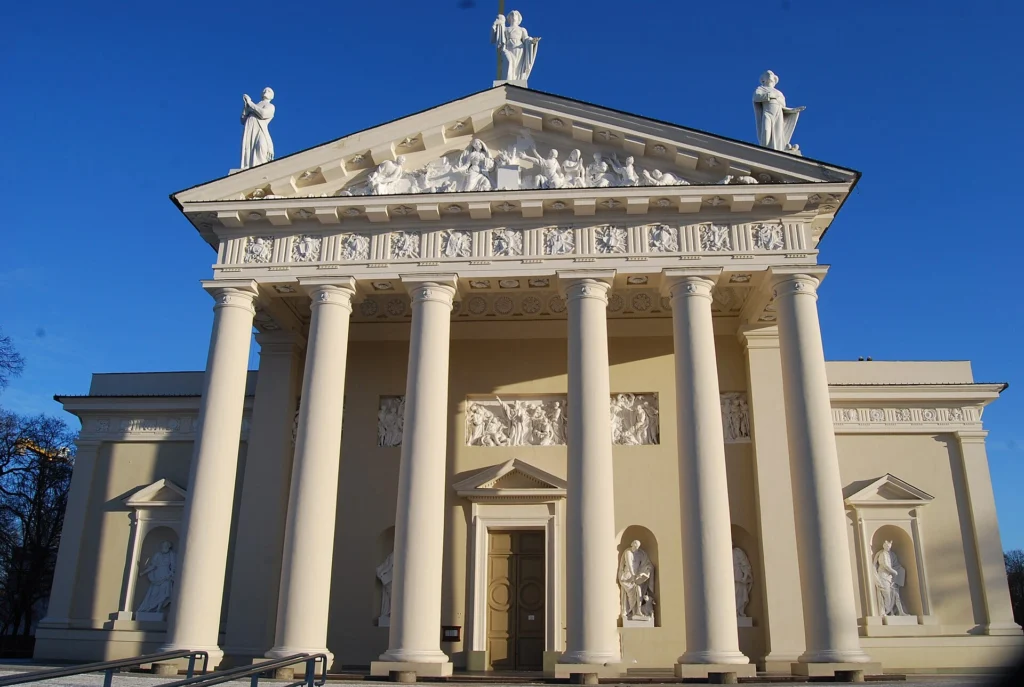
Architect: Laurynas Gucevičius
Architectural style: Gothic architecture, Baroque architecture, Neoclassical architecture.
Burials: Alexander Jagiellon, Barbara Radziwiłł.
Exterior and Sculptures
The Vilnius Cathedral is rectangular in plan, symmetrical, and built in the classicist style. It has a nave. There are six reliefs and 18 round sculptures on the cathedral’s exterior. Six massive columns line the entire width and height of the church’s portico on the facade. Three statues are placed on the portico: in the middle, Saint Helena, holding a large cross and the nails with which Jesus was nailed to the cross, on the right edge – the bishop of Krakow, martyr St. Stanislaus, to the left St. Casimir. These sculptures are copies of sculptures destroyed in 1950. They were created in 1997 by sculptor Stanislaus Kuzma. The “Noah’s Ark” high relief in the center of the pediment supports the sculptures. The high relief depicts men and women kneeling around a burning altar and raising their hands to heaven. A carved stone frieze surrounds the shelter and the church. The cathedral’s main space is supported structurally by its two domes, which are arranged on its sides. On the right side of the cathedral is the Chapel of St. Casimir, which stands out thanks to its grayish limestone color. The chapel’s foundation is commemorated by a plaque on its outer wall. The inscription is made of marble, the frames are made of sandstone. St.Casimir rests in this chapel. The cathedral has eleven chapels all together. A knife-wielding sculpture of Abraham can be found in the left niche of the church facade.
A Moses sculpture can be found in the facade’s far right niche. The image of Moses features rays sticking out of his forehead. The God’s Law is on two stone tablets in his hands. The four evangelists, Matthew, Mark, Luke, and John, are sculpted in the niches of the main facade wall behind the columns. The evangelists are portrayed as angels, lions, oxen, and eagles in symbolic representation. The sizes of the niches are proportional to the sculptures. The sculptures were created by Tomaz Rigis. Above the sculptures are bas-reliefs depicting the works of the apostles. Saint Peter speaking to the crowd is the focus of the largest bas-relief composition in the center of the cathedral above the doors. In the fourteen niches of the side facade walls, on the left side, there are statues of kings, and on the right side, there are statues of apostles and saints of the community of Jesus. Saints are hung on the wall above the niches. St. Peter and Compositions with many figures on the life of Paul. The cathedral reconstruction project created by Laurynas Gucevius determined the locations and sizes of the sculptures on the main facade.
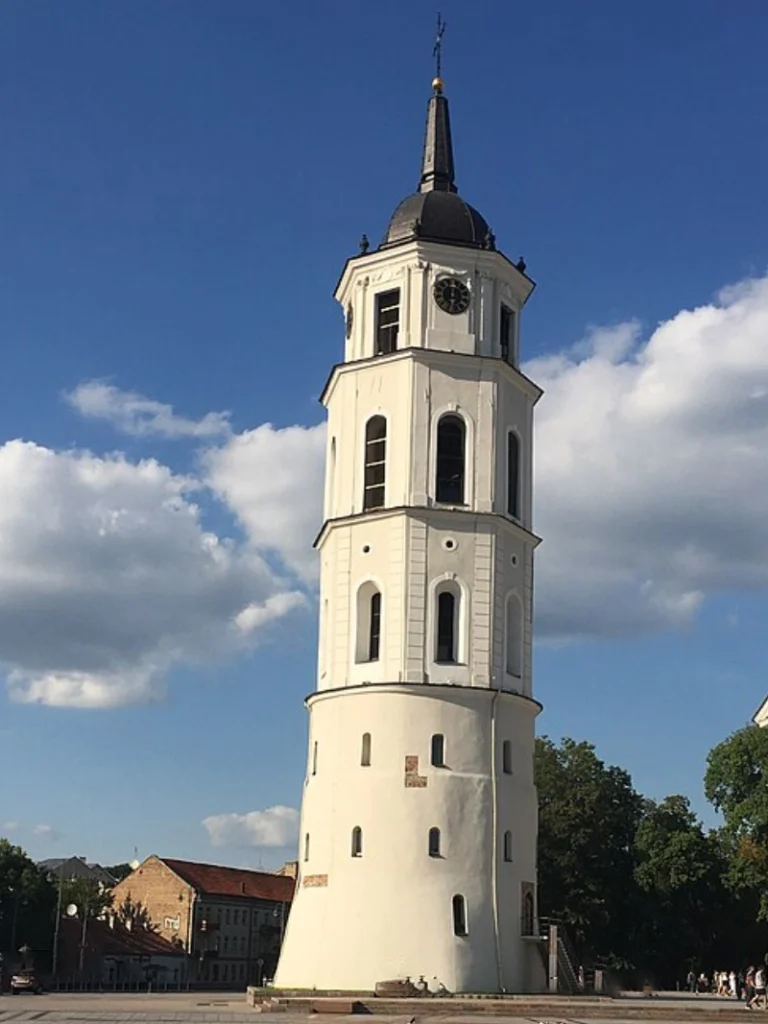
Vilnius Cathedral Bell Tower
The best-preserved tower of the Vilnius castle defensive wall, the 57-meter-tall bell tower with ten brass bells cast by Dutch and German masters between the 16th and 18th centuries, stands in front of the cathedral. A clock without a minute hand was installed here at the beginning of the 19th century. The underground quadrangular part of the bell tower is one of the oldest remains of masonry in Lithuania, built in the 13th century at the bottom of the Vilnius old ditch. The above-ground part of the bell tower is 52 m high (with a 2.8 m cross – 57 m). The three upper floors of the bell tower are octagonal, while the first floor is round. The dome ends in a pyramid.
The cathedral has six bells donated by His Excellency Cardinal Joachim Meisner of the Archdiocese of Cologne, the largest of which is named after Joachim, weighing 2,600 kg. The oldest bell has Renaissance features and was made between the late 16th and early 17th centuries. It is used for the tower clock. The other bells are Baroque. Figure compositions and ornamental bands adorn the 1673 cast bell by Jonas Delamars. The hours are counted by the bell. Famous masters Andriejs Dorling, Karolis Gotlybs Pars, Gustav Miorkas, and Pilypas Jokbas Ginteris also cast the remaining bells. In historical sources, the bell tower was first mentioned in 1522. It was being renovated at the time. The gaps were closed and the bell tower was plastered during the reconstruction. The bell tower’s third floor was built in 1598. The tower was completely destroyed by fire in 1610 The reconstruction of the bell tower was led by architect Vilhelmas Polis.

Cathedral Interior Design
The cathedral is built to a grand scale inside, with the choir supported by twelve large columns. The floor is made of stone slabs, and the cathedral features three main naves. Because the central nave is taller than the side naves, higher windows let in more light. The cathedral is a little bit darker, but it is still majestic, thanks to the smaller windows in the side naves. The vaults are cross-shaped and decorated with rosettes, resting on sixteen pillars. The pulpit is supported by one of the pillars. A decorative fence separates the presbytery from the rest of the cathedral.
Altars and Paintings
The cathedral has two main altars. The large one, located in the center, is designed in the classicist style. It has a pediment with tall columns and a gilded cross at the top. The decor is enhanced by stucco detailing, and the altar is constructed of artificial marble. A painting with the title “The Death of St. Stanislaus,” which Laurynas Gucevius designed to replace three previous altars, Behind the main altar is a smaller vicars’ altar, which holds a painting by Pranciškus Smuglevičius. This painting depicts Bolesław II the Bold killing St. Stanislaus, Kraków’s Bishop, in 1079. Paintings by the Italian artist Konstantinas Vilanis can be found on the side nave walls, and more works by Prancikus Smuglevius can be found further down the central nave. The cathedral is decorated with twelve paintings of the apostles and a painting of St. Stanislaus offering Mass, which can be seen at the end of the central nave. A Baroque-style organ with gilded ornaments is also housed in the cathedral. King David’s figure plays the harp in the middle, and angels play music on both sides of the organ.
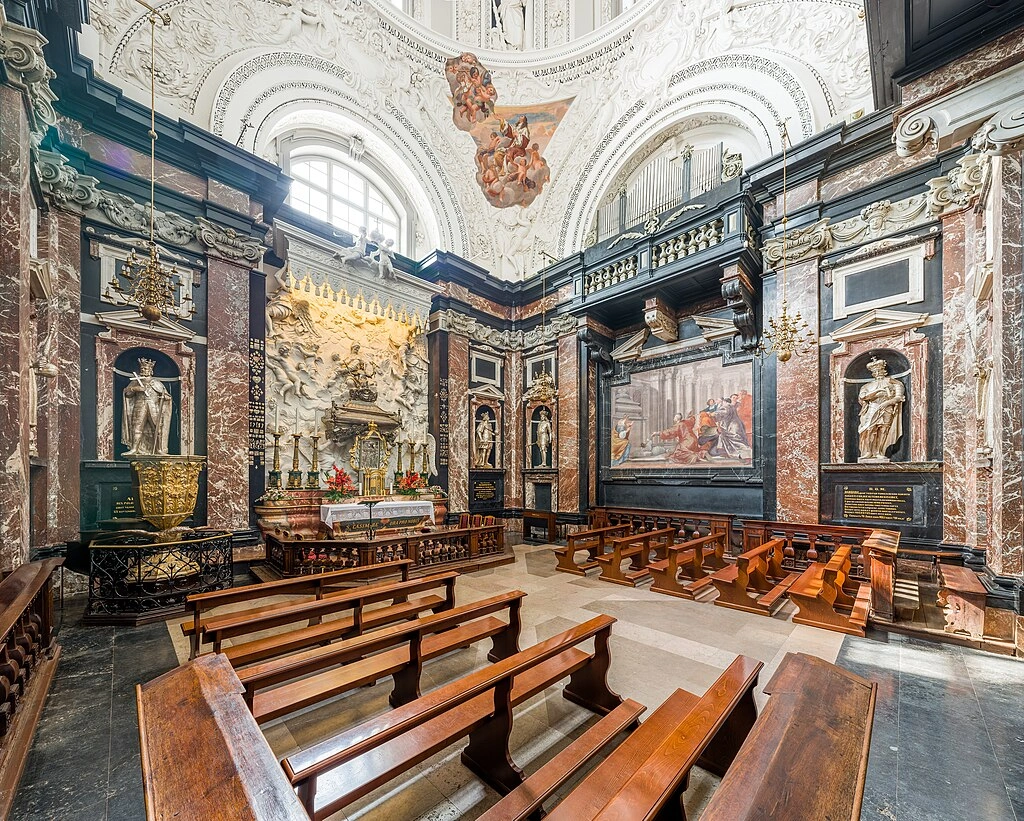
Casimir Chapel and Other Features
The Casimir Chapel, which houses the coffin containing St. Casimir. This chapel is considered one of the finest examples of early Baroque architecture in Lithuania. Laurynas Gucevius also designed the cathedral’s sacristy, which has a rotunda shape and houses a treasury with the royal insignia of King Alexander, Queen Elizabeth, and Barbara Radziwi.
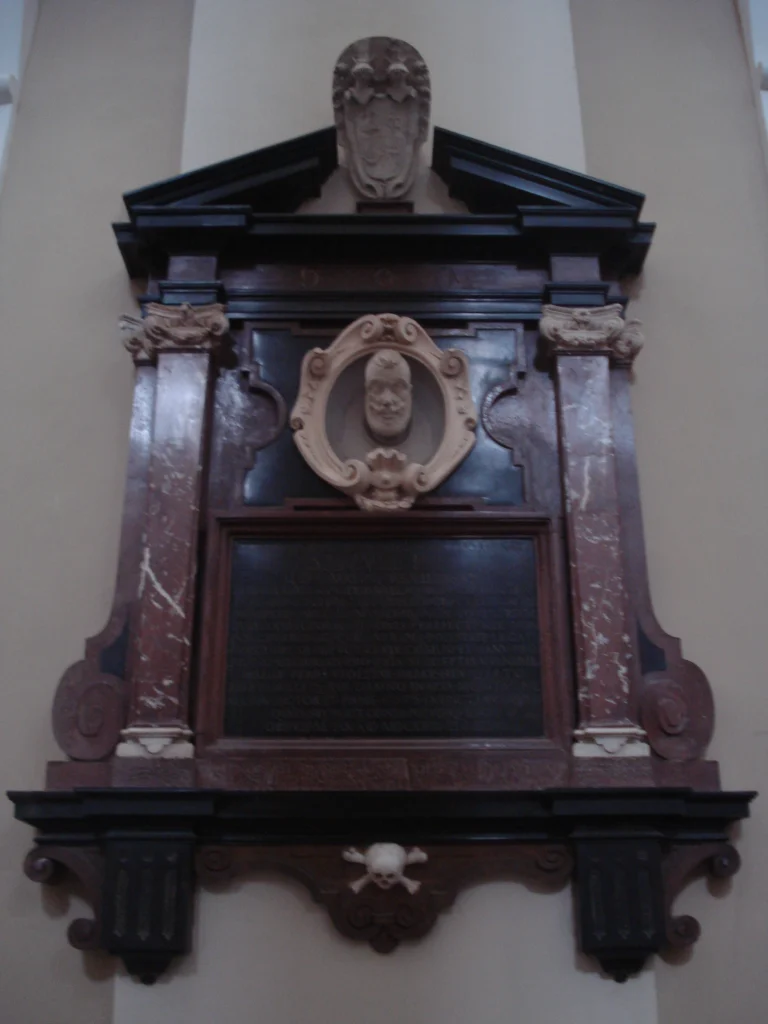
Epitaphs and memorial plaques
The cathedral has monumental epitaphs and memorial plaques. In the southern nave, close to the pilaster of the southern wall, hangs the Baroque epitaph of Samuel Pac, which was created between 1629 and 1633. It is made of limestone and brown, black marble. A memorial inscription is written on a slab that serves as the epitaph. A white portrait occupies an oval niche. A white heraldic shield is also used as decoration on the epitaph. Samuel Pac, the flag-bearer of the Grand Duchy of Lithuania, is honored in the epitaph. In the southern nave, near the pilaster of the southern wall, is where Jurgis Tikevius’s epitaph hangs. It is also Baroque and is made of bronze and marble. The bishop’s bust is carved and placed in a niche on the epitaph. Below it is a plaque with a memorial inscription. Around 1652, the epitaph was created. In the Valaviius Chapel, close to the eastern wall, is where Eustachius Valavius’s epitaph is located. Sandstone, stucco, and gray and brown marble make up its construction. Baroque is also present. The epitaph consists of a rectangular inscription slab and a framed upper part of the epitaph. A portrait of Bishop Eustachius Valavius occupies the epitaph’s center. In the northern nave, against the wall, is where Tomas Vaveckis’s epitaph hangs. Plaster, marble, and cast iron make up its construction. In a classicist style, the epitaph is gilded and plated in silver. The epitaph features a bust of Tomas Vavževskys placed in a niche and a plaque with a memorial inscription. The epitaph states that it was installed by Tomas Vavževskys’ brother.
The eastern wall of the Ksgailai Chapel houses Mykolas Liubiius Zaleskis’s epitaph. In the classicist style, it is made of marble. A figure composition and a memorial inscription embellish the epitaph. A cornice separates the composition from the slab. The epitaph inscription indicates that it is dedicated to the Grand Duchy of Lithuania figure Mykolas Liubičius Zaleskis (1744–1816). In the St. Mary’s Chapel, the epitaph of John of Nepomuk Kosakowski is displayed. Mary affixed to the eastern wall In the clerestory style, it is made of plaster, granite, and marble. A memorial plaque with the bishop’s portrait, insignia, and coat of arms embedded are the components of the epitaph. Near the eastern wall, in the northern nave, is where you’ll find the Vytautas memorial plaque. It consists of a gilded inscription on a slab of black marble. Ornaments are used to decorate the plaque. Eustachijus Tikevius was in charge of putting in this plaque. It repeats the inscription of the tombstone plaque installed for Vytautas by the Bishop of Vilnius Valerijonas Protasevičius in 1573 and burned down in a fire in 1610. The plaque honoring Bishop Andrius Benediktas Klongevius is located near the pilaster of the southern wall in the southern nave. Plaster is used to make it. Frames with decorative elements surround the memorial plaque. In the nineteenth century, the plaque was made. In the Ksgailai Chapel, near the western wall, a plaque honoring Vincentas Kliuinskis hangs. It is made of bronze. The plaque contains a portrait, and below it is a memorial inscription. In the first half of the 20th century, the plaque was made.

Cathedral chapels
There are a total of eleven chapels in the Vilnius Cathedral, each with its own significance and history. Laurynas Gucevius, an architect who had the goal of creating a space with a sense of harmony, brought these chapels together and arranged them.
Chapel of Saint Wladyslaw
The first chapel to the left as you walk in is the Chapel of Saint Wladyslaw. Gucevius constructed this chapel, which stands where the cathedral’s Royal Chapel sacristy and a tower were before they were destroyed by fire in 1530. It’s oval in shape with a dome. A plaque honoring Vilnius’s influential Bishop Benediktas Vaina can be found next to the chapel.
The Chapel of the Holy Virgin Mary (Walavičiai Chapel)
The Holy Virgin Mary Chapel, also known as the Walaviiai Chapel or the Old Royal Chapel, comes next. King Casimir Jagiellon, the son of the Polish king and Grand Duke of Lithuania, established this chapel many years ago. It was designated as the final resting place for St. Casimir and a few others It was tragically destroyed by fire in 1530, but Sigismund the Elder rebuilt it in 1534. Later, in 1547, Sigismund Augustus and Barbora Radziwill secretly married here. The four evangelists are painted on a beautiful dome in the rectangular space. A painting from the 17th century depicts the Virgin Mary surrounded by clouds on this altar.
The Ksgailai Chapel is next to the Valaviiai Chapel. Built in 1436 by Mykolas Ksgaila, the Vilnius Voivode and Chancellor of Lithuania, it is closed and closed to visitors. In honor of the first Franciscans martyred in Vilnius, a memorial plaque has been incorporated into the chapel’s wall. The memorial plaque was moved to this chapel from the Franciscan Church. The Chapel of the Holy Sepulchre, which is also closed, comes next. Karolis Podainskis, a professor at Vilnius University, was the one who designed the “Christ’s Sepulchre.” The cathedral’s northern entrance is further behind this chapel. It was built in place of an old chapel, called the second Kęsgailai Chapel. Two sacristies are located behind the side entrance. In the left nave, the Chapel of Blessed Relics was opened in 2018, where the relics of two blessed archbishops of Lithuania – Pal. Pal and Jurgis Teofilius is a god of honor. The relics were transferred from the central altar to the chapel, which is decorated with images of the blessed Jurgis Matulaitis (1871–1927) and Archbishop Teofilius Matulionis (1873–1962). The cathedral’s sacristy can be found at the far end of the left nave. It has a dome and is octagonal. Albertas Vaitiekus ametas was the artist who painted the dome. A gate separates the cathedral’s sacristy from the side nave. The church of Saint Duke Sigismund Vasa started Casimir in the right nave and finished it by Warsaw IV. The chapel’s interior is lined with marble and is constructed of Swedish sandstone. Baroque in style, the chapel is square. The saint’s coffin is on display at its altar. Casimir. Behind the doors of the St. Casimir Chapel, also known as Bishops’ Chapel, was constructed by Bishop John of Vilnius with funds from the Lithuanian dukes at the beginning of the 16th century. Since 1537, the bishops of Vilnius were buried in the basement under the chapel. The artist Jurgis Hopenas was responsible for the creation of the Bishops’ Chapel wall decorations. In the chapel, a plaque honoring Bishop Antanas Prancikus Audzevius hangs. Bishop Ignotas Jokūbas Masalskis and Archbishop Julijonas Steponavičius are buried in the chapel’s basement. The chapel, whose name has changed, comes next. In its basements, the bishops of Vilnius were also buried. In the chapel, a plaque honoring Bishop Jonas Civinskis hangs. The chapel includes an office. Next to this chapel is a side entrance, through which the cathedral is entered from the square. Behind this chapel is the Montvydai Chapel, built by Laurynas Gucevičius. The chapel’s property was taken after the cathedral was closed. In the 15th century, the Trakai voivode Martynas Gotautas established the Gotautai Chapel, which is further away. Two Renaissance tombstones of the Chancellor of the Grand Duchy of Lithuania Alberts Goštautas and Bishop Povilas Alšėniškis are installed in the walls of the Gostautai Chapel.
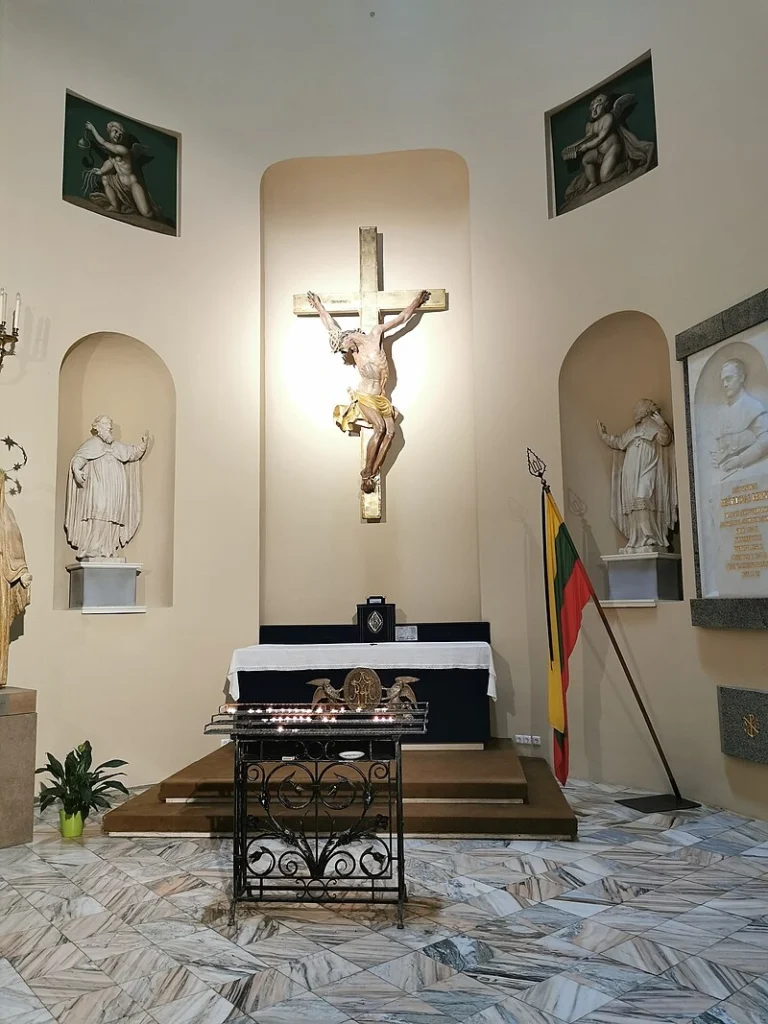
Chapel of Exiles
Finally, you’ll find the Chapel of Exiles near the cathedral’s main doors. The memory of those who suffered under the Soviet regime is honored in this chapel. It’s also the final resting place of Bishop Jonas Nepomukas Kasakauskas of Vilnius, and you can see his memorial plaque on the left wall. The chapel’s niches hold statues of saints, and above the altar hangs the Crucifix that was originally from the Walavičiai Chapel.
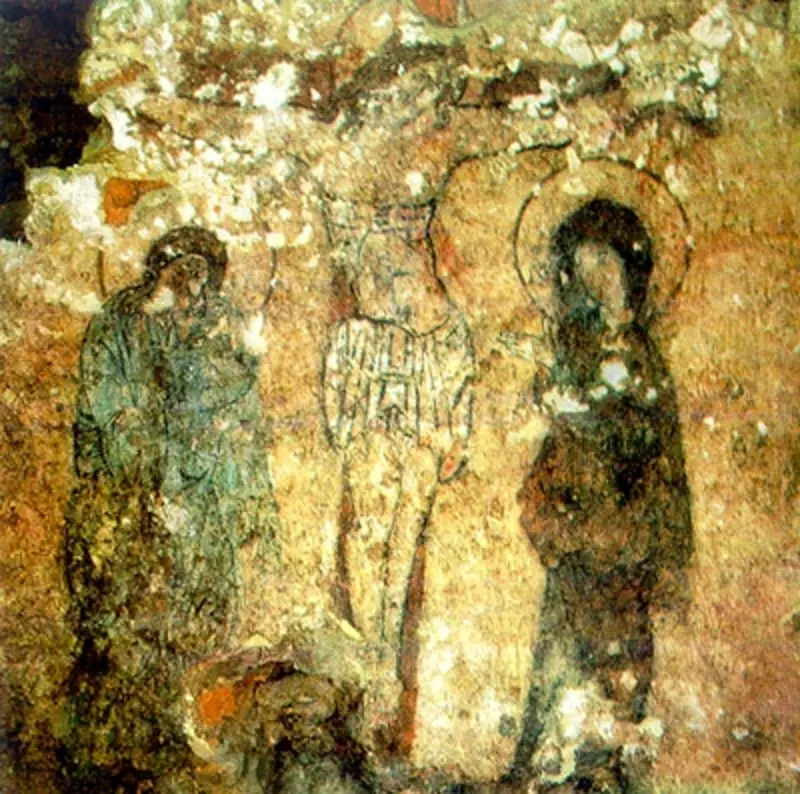
Cathedral crypts
The cathedral’s basement has 27 cellars at the moment. It is possible to move from one cellar to another because some are grouped together. The exhibition in the basement of the cathedral depicts the cathedral’s history, including the various stages of its construction and reconstruction, from the first Lithuanian cathedral built by King Mindaugas in the 13th century to its most recent reconstruction, which was carried out in accordance with the plan of architect Laurynas Guceviius (1753–1798). Nobles, bishops, and princes from the Grand Duchy of Lithuania were buried in the cathedral’s crypts. Princes were typically buried in crypts beneath the floors of side chapels or naves. There are a total of twenty crypts. Some crypts have names such as the Kings’ Crypt, the Chapter’s Crypt, and the Bishops’ Crypt. Laurynas Gucevius had sealed off the crypts’ entrances with bricks. In 1930, only the crypts of the Valaviiai and Gotautai chapels were accessible to researchers. Buried in the cathedral are: Grand Duke Vytautas of Lithuania (1430), his first wife, wife Ona (1418). Aleksandras Vygantas (1392), Karigaila (1390), Grand Duke ygimantas Kstutaitis (1440), Jogaila’s brother Grand Duke vitrigaila (1452), Vytautas’ brother ygimantas Kstutaitis’ son Mykolas (1452), and St. Alexander (1506), Duke Sigismund Augustus’ first wife Elizabeth of Habsburg (1545), and Barbora Radziwill (1551), Chancellor of the Grand Duchy of Lithuania Albert Gotautas, Bishop Valerijonas Protaseviius (1580), Casimir (1484–1602), Grand Duke of Lithuania and King of Poland The oldest fresco in Lithuania, dating from the end of the 14th century, depicts Christ’s crucifixion in the cathedral’s crypts.
Findings
In 1931, workers made an extraordinary discovery in the cathedral’s basement a crypt containing the remains of Grand Duke Alexander of Lithuania, along with the remains of Sigismund Augustus’ two wives, Elizabeth of Habsburg and Barbora Radziwill. Wooden coffins were used to bury all three of them. Subsequently, a mausoleum was constructed beneath the Chapel of St. Casimir. Then, in 1986, additional graves were discovered at varying depths between the central crypt and the cathedral’s western walls. On December 16, 2024, the most recent discovery was discovered. The Lithuanian and Polish crowns that had been buried since 1939 were finally discovered. The items included: The crown of Alexander, King of Poland and Grand Duke of Lithuania Crown, chain, medallion, ring, and tablet for the coffin belonged to Elizabeth of Habsburg. Barbora Radziwill’s crown, scepter, orb of power, three rings, chain, and two coffin tablets. After the rulers’ deaths, these crowns and other items were minted with the intention of being used as tombstones for their final resting places.
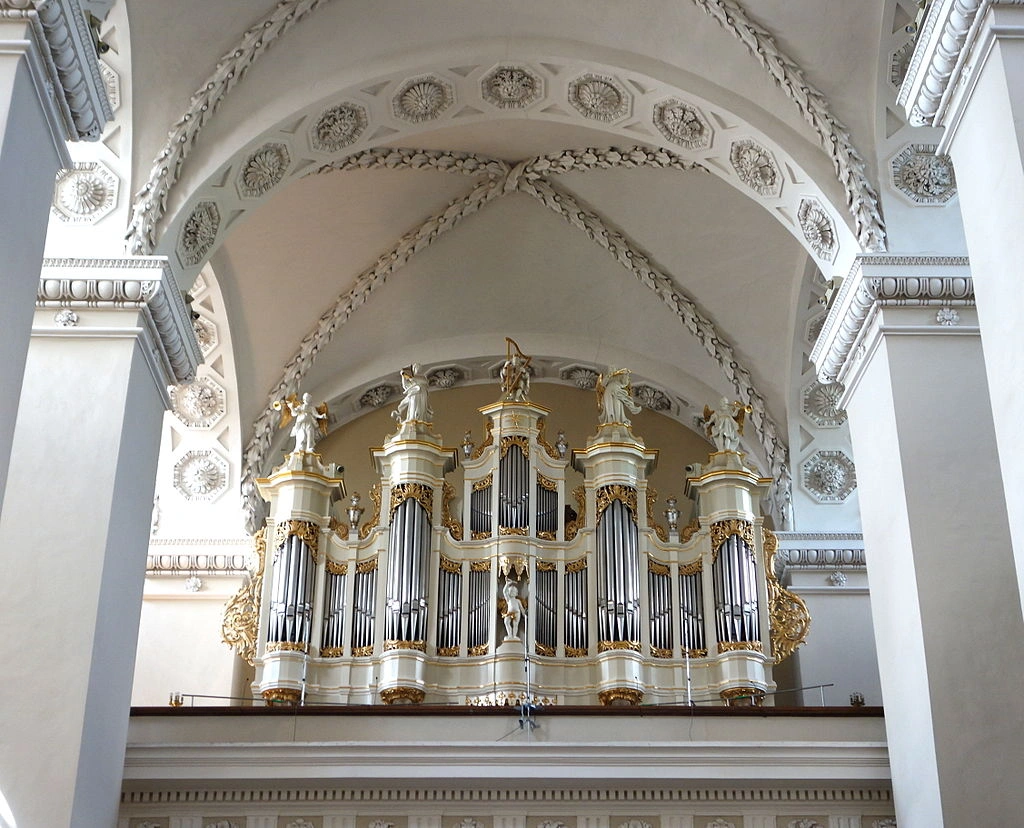
Pipe Organ
The cathedral’s counter-façade is viewed from the Alexander Schuke pipe organ, which is situated on the choir loft. It was built in 1969 under the name opus 403, but the case itself is much older Nicolaus Jentzen made it in 1780. This organ has a unique setup with mixed transmission: the manuals and pedal are mechanical, while the registers are electro-pneumatic. It features three keyboards, each with 56 notes, and a 30-note pedalboard. The main pipes in the massive wooden case are shaped like shields and are beautifully decorated with sculptures and statues. It is divided into several sections. Both in terms of design and sound, it is truly a masterpiece.
Feast Day
Feast Day : 11 April – St. Stanislaus 27 June – St. Vladislaus
The Cathedral Basilica of St. Stanislaus and St. Vladislaus in Vilnius, Lithuania, honors its two patron saints with dedicated feast days. The feast of St. Stanislaus, one of the principal patrons, is celebrated on April 11, while the feast of St. Vladislaus (also known as St. Ladislaus) takes place on June 27. The feast of St. Casimir, Lithuania’s patron saint, is also important and is observed on March 4.
Church Mass Timing
Monday to Saturday : 8:00 AM, 12:30 PM, 05:30 PM
Sunday : 8:00 AM, 9:00 AM, 10:00 AM, 11:15 AM, 12:30 PM, 05:30 PM, 06:30 PM
Church Opening Time:
Monday to Sunday : 07:00 am – 6:00 pm
Contact Info
Address : St. Michael’s Cathedral
Šventaragio g., Vilnius, 01143 Vilniaus m. sav., Lithuania.
Phone : +370 5 261 1127
Accommodations
Connectivities
Airway
Cathedral Basilica of St. Stanislaus and Vladislaus, Vilnius, Lithuania, to Vilnius International Airport, distance 16 min (6.8 km) via Dariaus ir Girėno g.
Railway
St. Michael’s Cathedral Basilica, Veszprém, Hungary, to Vilnius Railway Station, distance between 10 min (3.3 km) via Maironio g.


